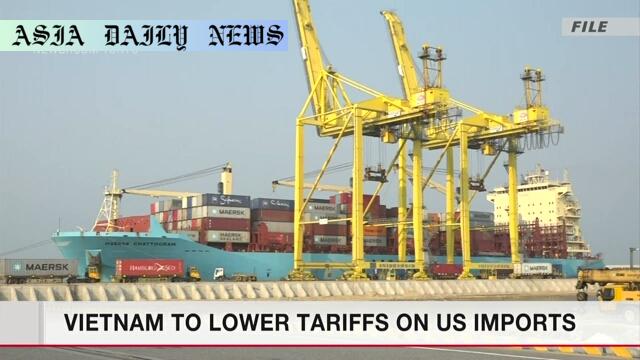Tariffs – Vietnam announces measures to lower tariffs on US imports, targeting food, energy, and automobiles amidst trade concerns.
- Vietnam announced lowering tariffs on US food, energy, and automobile imports.
- The effort aims to address Vietnam’s trade surplus with the US, its third-largest globally.
- The US plans to impose reciprocal tariffs on countries with high trade barriers on April 2.
- Nearly 30% of Vietnam’s exports are destined for the US, a significant part of its economy.

Vietnam’s Response to US Tariff Concerns
Vietnam has recently announced measures to reduce tariffs on a range of US imports, including food, energy, and automobiles. This decision comes as President Donald Trump prepares to enforce reciprocal tariffs on countries with significant trade surpluses and high import restrictions, a policy anticipated to take effect on April 2. By proactively lowering tariffs on US goods, Vietnam aims to safeguard its economic ties with its largest export destination—where nearly 30% of its products are sent annually.
Hanoi’s decision illustrates the importance of US-Vietnam trade dynamics, especially since Vietnam ranks as the third-largest trade surplus holder with the United States, after China and Mexico. A reduction in tariffs not only positions Vietnam as a cooperative trading partner but also helps secure access to the lucrative US market amid escalating global trade tensions.
Impacts on US-Vietnam Trade Relations
The reduced tariffs are expected to boost imports of US goods such as agricultural products, energy resources, and automobiles into Vietnam. This could help address current trade imbalances between the two nations, potentially lowering Vietnam’s surplus with the United States. Vietnam’s Finance Ministry emphasized that this step aligns with the country’s broader objectives of maintaining balanced trade and diversifying import sources.
For Vietnam, maintaining harmonious economic relations with the US is vital for its export-driven economy. With America accounting for a significant portion of Vietnam’s GDP through exports, any disruption in trade ties could have substantial repercussions. Conversely, the tariff reductions may open up new opportunities for American businesses to penetrate Vietnam’s growing consumer market.
A Preemptive Strike Against Potential Trade Barriers
Given indications that the US intends to impose hefty tariffs on April 2, Vietnam’s tariff adjustments appear to be a proactive step to mitigate potential economic fallout. President Trump’s emphasis on reciprocal levies reflects his administration’s intent to address perceived inequities in international trade agreements. Countries like China and Vietnam, with significant trade surpluses, have been under scrutiny due to concerns about unfair trade practices or barriers limiting American exports.
By signaling a willingness to cooperate and make concessions, Vietnam positions itself as a responsible trading nation keen on fostering mutual economic growth. This move could place the country in a favorable light, potentially exempting it from harsher reciprocal measures under the US trade policy.
The Broader Economic Implications
Vietnam’s openness to reform is indicative of its pragmatic approach to managing global economic dynamics. The country’s dependence on export-led growth necessitates stable relationships with major trade partners like the US. Additionally, reducing tariffs on imports could align with Vietnam’s goals of modernization and industrialization, as it fosters access to advanced technologies, machinery, and energy resources from US producers.
In the long term, these tariff reductions may encourage greater bilateral cooperation in other sectors, such as education, infrastructure, and clean energy initiatives. American businesses may find this development encouraging, signaling Vietnam as an appealing market for investment. Conversely, Vietnam’s efforts also reveal the stakes of potential trade conflicts for smaller but globally integrated economies.
Future Trade Prospects
As global trade tensions continue to simmer, Vietnam’s proactive approach demonstrates how nations can adapt to challenges while protecting their economic interests. By balancing tariff reductions with its need to maintain a competitive edge in international markets, Vietnam appears to signal a long-term commitment to equitable trade with the US. These developments underscore the benefits of dialogue and cooperation in addressing trade disputes, setting a potential precedent for other nations grappling with similar challenges.



Commentary
Vietnam’s Strategic Move to Lower US Tariffs
Vietnam’s decision to reduce tariffs on US imports is a noteworthy display of strategic economic diplomacy. This move reflects the country’s understanding of the changing global trade environment, where protectionism and reciprocal tariffs are gaining momentum. By addressing its trade surplus with the US, Vietnam appears to be preempting any potential fallout from the upcoming trade measures announced by President Trump.
The move to lower tariffs on American goods also signifies Vietnam’s recognition of its dependence on the US as a key trade partner. With nearly 30% of its exports headed to the United States, Vietnam acknowledges that maintaining strong economic relations is critical to sustaining its growth. At the same time, these concessions could introduce new opportunities for American businesses to tap into the Vietnamese market, fostering mutual economic benefits for both nations.
The Benefits and Risks of Vietnam’s Tariff Reductions
The decision showcases Vietnam’s willingness to adapt its policies to meet the challenges posed by the evolving international trade climate. Cutting tariffs on food, energy, and automobiles not only levels the playing field for US exporters but also demonstrates Vietnam’s commitment to balancing trade relationships. The move may also catalyze further reforms in Vietnam’s trade practices, providing long-term benefits for its economy.
However, it is essential to acknowledge the risks. By reducing tariffs, Vietnam may expose certain domestic industries to increased competition from American imports, potentially challenging smaller businesses. This highlights the importance of complementary domestic policies to safeguard local sectors and workforce resilience during this transition.
Looking Ahead
In a world increasingly marked by trade frictions, Vietnam’s approach to addressing these issues pragmatically is both commendable and forward-looking. By taking calculated steps to mitigate potential economic fallout, Vietnam is ensuring that it remains a vital player in the global trade landscape. This development should encourage other nations to likewise pursue cooperative strategies that align with mutual economic growth. Moving forward, partnerships between Vietnam and the US could further deepen, paving the way for enhanced economic collaboration in a post-tariff era.